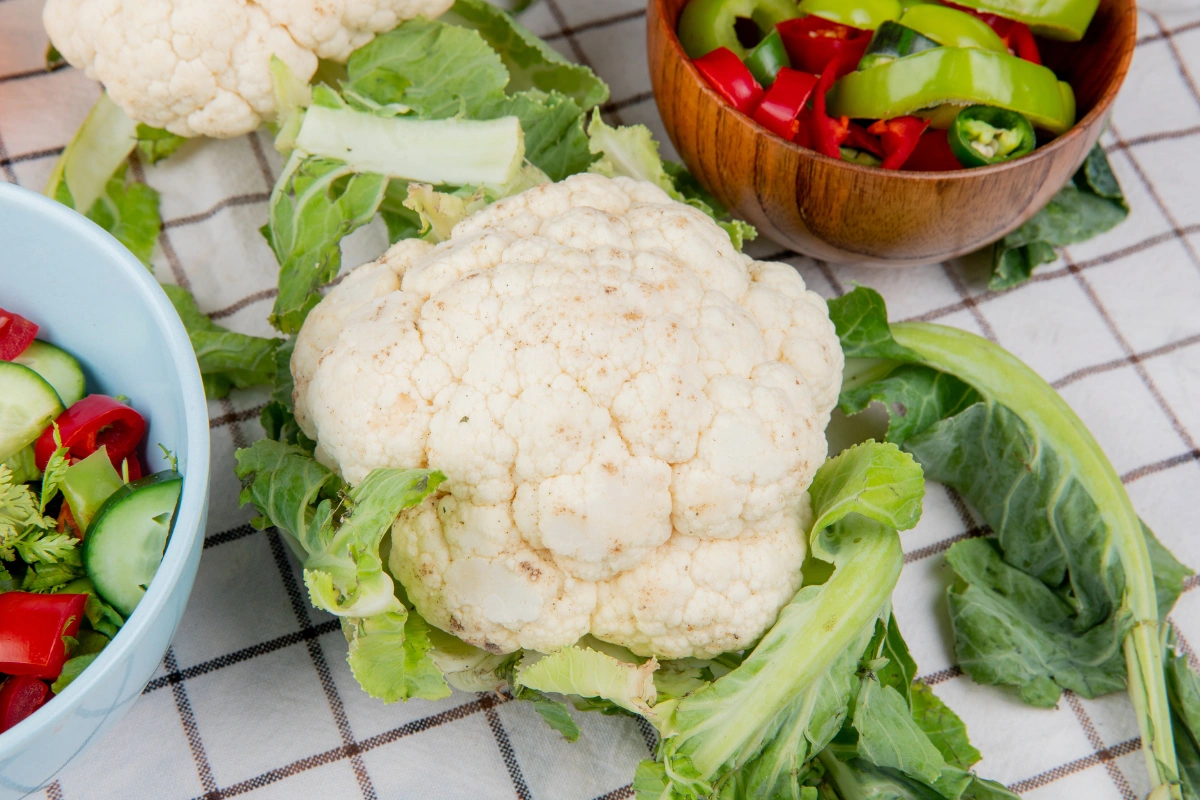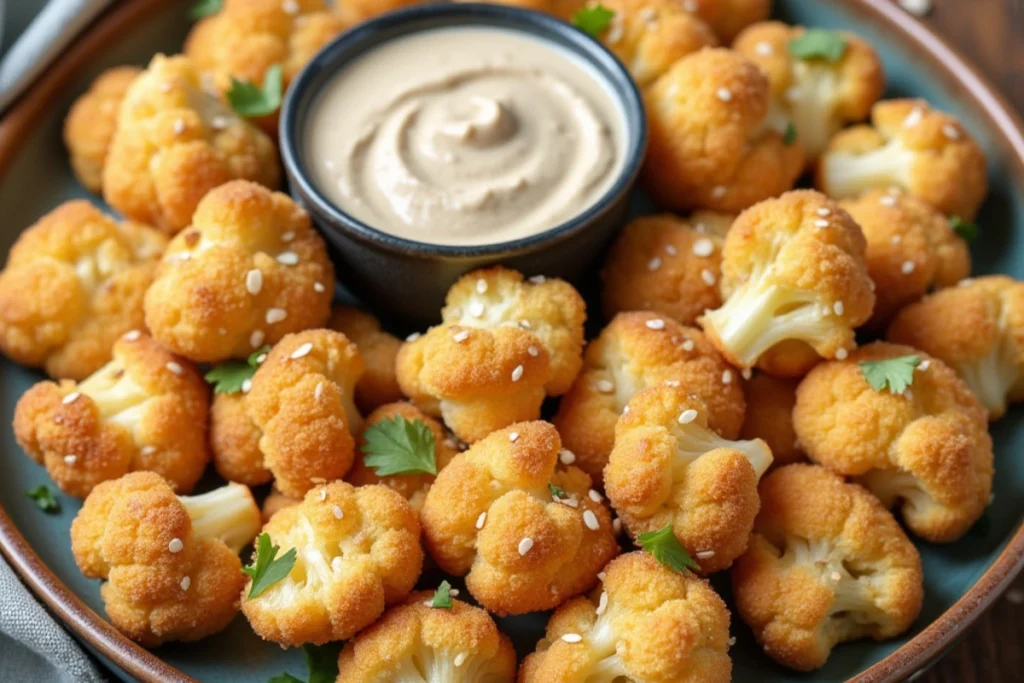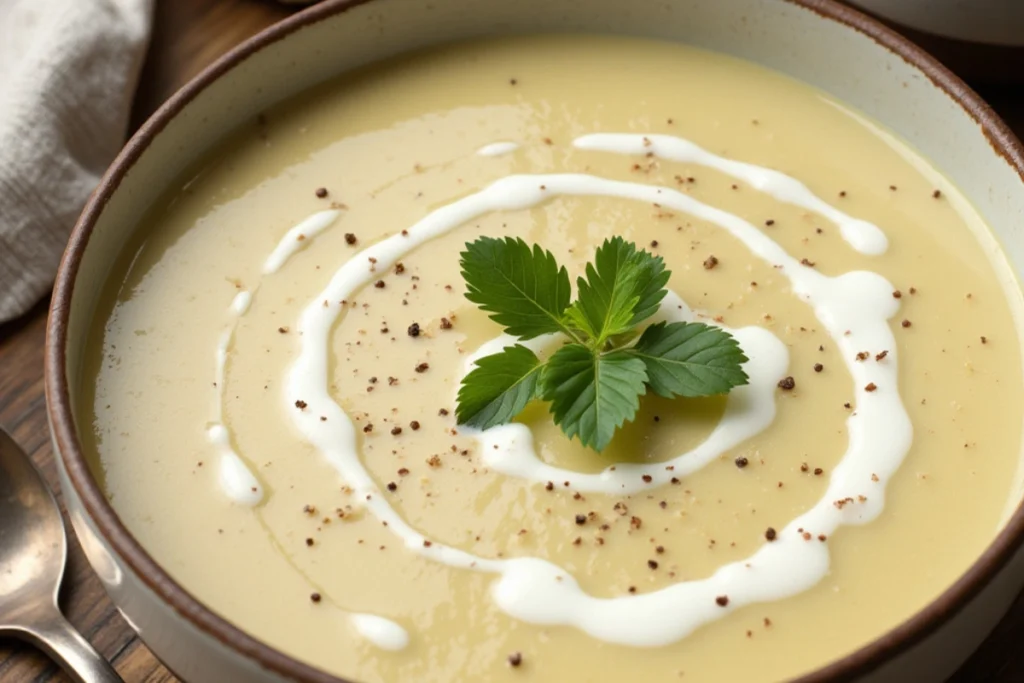Cauliflower has become a star ingredient in vegan cooking, thanks to its versatility, mild flavor, and nutritional benefits. This humble vegetable is an excellent choice for creating dishes that are both delicious and satisfying. Whether you’re new to vegan cooking or a seasoned chef, vegan cauliflower recipes provide endless possibilities. This article highlights why cauliflower is a kitchen staple, examines its health benefits, and includes a variety of creative recipes. It also offers essential cooking tips and answers common questions about working with cauliflower. Additional insights can be found in vegan gluten-free recipes that showcase cauliflower’s versatility in plant-based diets.
Why Cauliflower is a Vegan Kitchen Staple
The Nutritional Power of Cauliflower
Cauliflower is a nutrient-dense vegetable that offers numerous health benefits. Packed with vitamins like C, K, and folate, it serves as an excellent addition to a balanced diet. Its low-calorie content, combined with high fiber, makes it beneficial for weight management and digestion. Furthermore, cauliflower contains antioxidants that help reduce inflammation and promote overall health. Recipes like vegan cauliflower curry and roasted cauliflower Alfredo highlight how this vegetable can be incorporated into flavorful and nutritious dishes.
The Versatility of Cauliflower in Vegan Cooking
Cauliflower’s mild, neutral flavor and unique texture make it one of the most adaptable vegetables in the kitchen. From replacing rice and pasta to mimicking meat in vegan dishes, cauliflower fits seamlessly into a wide range of recipes. Its ability to absorb flavors from spices and marinades ensures it complements virtually any cuisine. Dishes such as cauliflower fried rice and vegan cauliflower steaks demonstrate how this versatile vegetable can transform into delicious meals.
Essential Ingredients and Tools for Cooking with Cauliflower
Creating vegan cauliflower recipes requires a few key ingredients and tools to achieve the perfect flavor and texture. With the right components, you can effortlessly transform cauliflower into a variety of delicious dishes.
Ingredients That Complement Cauliflower
Spices and Herbs
Spices and herbs are essential for enhancing cauliflower’s natural flavor. Paprika, turmeric, and cumin add warmth and depth, while garlic and onion powder boost the savory profile. Fresh herbs like parsley, cilantro, and dill provide a refreshing finish to roasted or grilled cauliflower. Recipes like spiced cauliflower bites and herb-roasted cauliflower demonstrate how these seasonings can transform simple cauliflower dishes into flavorful creations.
Sauces and Marinades
Cauliflower’s ability to absorb flavors makes sauces and marinades indispensable. For richness and complexity, vegan cheese sauces, tahini, coconut milk, and soy-based sauces are excellent choices. Additionally, for bold and spicy recipes, buffalo sauce or sriracha can be used to coat cauliflower for baking or frying.
Whole Food Pairings
Cauliflower pairs wonderfully with other plant-based staples. Chickpeas and lentils contribute protein and texture, while quinoa or brown rice create a hearty base for grain bowls or salads. Tofu or tempeh complements cauliflower in curries and stir-fries, making the dish both filling and nutritious. Recipes like vegan cauliflower stir-fries and grain bowl combinations showcase how cauliflower can be combined with these staples to craft wholesome meals.
Must-Have Kitchen Tools
Food Processor
A food processor is ideal for making cauliflower rice, which can easily replace traditional grains in recipes. It’s also useful for creating cauliflower-based crusts or doughs, ensuring versatility in vegan cooking.
High-Quality Baking Sheets
Baking sheets are crucial for roasting cauliflower. A sturdy, non-stick surface not only ensures even cooking but also helps achieve crisp edges for a delightful texture.
Blender
A blender is indispensable for creamy soups, sauces, and purees. It helps achieve the silky textures that elevate vegan cauliflower dishes, such as Alfredo sauce or creamy soups.
10 Creative Vegan Cauliflower Recipes
Cauliflower is one of the most versatile vegetables, making it a staple in vegan kitchens. It lends itself to a wide range of dishes that cater to different tastes and occasions. Below are ten creative vegan cauliflower recipes that highlight its adaptability.
Appetizers and Snacks
Cauliflower Buffalo Wings
For a bold and spicy snack, crispy cauliflower florets coated in a flavorful buffalo sauce are an excellent choice. Serve them alongside vegan ranch or celery sticks to complete the classic pairing. As a result, these wings are both satisfying and crowd-pleasing.
Cauliflower Bites with Tahini Dip
When you’re in the mood for something wholesome, oven-baked cauliflower bites paired with creamy tahini dip are perfect. Additionally, sprinkling sesame seeds or fresh herbs on top elevates the flavor and presentation.
Soups and Salads
Creamy Cauliflower Soup
This dairy-free soup is made velvety by blending roasted cauliflower with coconut milk. To enhance the flavor, season it with garlic and onion. Furthermore, it’s an ideal option for a cozy and comforting meal.
Roasted Cauliflower and Quinoa Salad
For a nutritious meal, try this salad that combines roasted cauliflower, cooked quinoa, and a tangy lemon-tahini dressing. Moreover, adding pomegranate seeds or nuts provides a delightful mix of textures and flavors.
Mains
Cauliflower Steak with Chimichurri
Thick slices of cauliflower are roasted or grilled until golden brown, then topped with herbaceous chimichurri sauce. Not only is it simple to prepare, but it’s also an elegant main course for special occasions.
Vegan Cauliflower Curry
A hearty curry made with cauliflower, chickpeas, and coconut milk is a comforting choice. Pair it with rice or naan, and you have a satisfying, plant-based meal. Additionally, adjusting the spices allows you to customize the flavor to your preference.
Rice and Pasta Alternatives
Cauliflower Fried Rice
Low-carb cauliflower rice stir-fried with soy sauce, peas, carrots, and tofu offers a healthier twist on traditional fried rice. Furthermore, adding a dash of sesame oil enhances its umami flavors, making it irresistibly tasty.
Cauliflower Alfredo Sauce Over Pasta
Blended cauliflower creates a creamy Alfredo sauce that pairs beautifully with fettuccine or penne. By incorporating garlic, nutritional yeast, and plant-based milk, you achieve a rich and indulgent sauce without dairy.
Baked and Grilled
Whole Roasted Cauliflower
A whole head of cauliflower marinated in spices and roasted to golden perfection is truly a show-stopper. Moreover, it’s perfect for special occasions or family meals, as it’s both flavorful and visually impressive.
Grilled Cauliflower Tacos
Smoky, spiced cauliflower florets served in soft tortillas with salsa and avocado create an exciting plant-based taco option. To finish, garnish with fresh cilantro and a squeeze of lime for added zest.
Tips for Cooking Perfect Cauliflower Recipes
To make the most of your vegan cauliflower recipes, it’s important to focus on proper preparation and cooking techniques. These tips ensure that your dishes turn out flavorful, textured, and visually appealing every time.
How to Prep Cauliflower
Prepping cauliflower correctly sets the foundation for a great dish. Start by thoroughly washing the head of cauliflower to remove any dirt or debris. To make cutting easier, remove the outer leaves and cut the head into florets. If you’re planning to roast or grill the cauliflower, try to keep the florets evenly sized for consistent cooking. Additionally, for recipes like cauliflower rice or vegan cauliflower tacos, use a food processor to achieve a fine texture and uniform consistency.
Achieving the Perfect Texture
The texture of cauliflower can make or break a dish. For crispy roasted cauliflower, coat the florets evenly in oil and spread them out on a baking sheet to avoid steaming. Use high heat (400–425°F) for a golden-brown result. Steaming or boiling cauliflower for soups or mashes requires careful timing, as overcooking can make it mushy. Grilling adds a smoky flavor and a slightly charred exterior, which works well in tacos or as a main dish. Techniques like roasting cauliflower or incorporating it into vegan tacos highlight how proper preparation elevates its texture and taste.
Seasoning Tips
Seasoning is key to transforming cauliflower into a flavorful dish. A combination of spices, marinades, or sauces enhances its natural taste. Spices like smoked paprika, cumin, and turmeric add depth to roasted cauliflower, while fresh herbs such as parsley and cilantro bring brightness to salads. Marinating cauliflower in soy sauce, lemon juice, or tahini ensures every bite is packed with flavor. Recipes such as seasoned roasted cauliflower and tahini-marinated cauliflower dishes showcase how the right seasonings can elevate simple ingredients into culinary delights
Serving and Storing Vegan Cauliflower Dishes
How to Serve Vegan Cauliflower Recipes
Vegan cauliflower recipes are highly versatile, making them suitable for a variety of occasions. Here are some ideas to elevate your dishes:
- As Appetizers or Snacks: Serve dishes like buffalo cauliflower wings or roasted cauliflower bites with dipping sauces such as vegan ranch, tahini, or sriracha mayo. These are great for parties, game nights, or casual gatherings.
- As Main Courses: Recipes like cauliflower curry, steaks, or tacos can stand alone as hearty and satisfying meals. Pair them with rice, quinoa, or a fresh salad to create a well-rounded dish.
- As Side Dishes: Roasted cauliflower or creamy cauliflower soup can complement mains like vegan lentil loaf or grilled tofu. These versatile options work well for family dinners or holiday feasts.
- In Bowls or Wraps: Add roasted cauliflower to grain bowls or wraps for a nutritious and flavorful meal. Layer it with ingredients like avocado, greens, and a drizzle of tahini or lemon dressing.
Tips for Storing Vegan Cauliflower Dishes
Proper storage helps maintain the freshness and flavor of your cauliflower dishes. Follow these tips to store them effectively:
- Refrigeration: Store cooked cauliflower dishes in airtight containers in the refrigerator for up to 3–5 days. Ensure the dish has cooled completely before sealing it to prevent moisture buildup.
- Freezing: Many cauliflower-based recipes, such as roasted cauliflower, soups, or curries, freeze well. Place portions in freezer-safe containers or bags and label them with the date. Frozen dishes can be stored for up to 3 months.
- Reheating: For best results, reheat cauliflower dishes in the oven or on the stovetop to restore their texture. Avoid microwaving roasted cauliflower, as it may lose its crispness.
- Storing Raw Cauliflower: If you’re storing raw cauliflower, keep the head in its original packaging or wrap it loosely in a plastic bag. Place it in the crisper drawer of your refrigerator, where it will stay fresh for up to a week.
Frequently Asked Questions About Vegan Cauliflower Recipes
To help you perfect your vegan cauliflower recipes and address common challenges, here are answers to frequently asked questions.
Can I Freeze Cauliflower Dishes?
Yes, many cauliflower dishes freeze well. For best results, freeze roasted or cooked cauliflower in an airtight container or freezer bag. When you’re ready to use it, thaw in the refrigerator and reheat in the oven or on the stovetop. Cauliflower rice can be frozen raw and cooked straight from frozen.
How Do I Avoid Mushy Cauliflower?
To prevent mushiness, avoid overcooking cauliflower. Roasting at high heat (400–425°F) creates a crisp exterior, while steaming or boiling should be done for just a few minutes. Additionally, spreading cauliflower out in a single layer on a baking sheet ensures even cooking and prevents steaming.
What’s the Best Way to Store Cauliflower?
Store raw cauliflower in the refrigerator, either in its original packaging or in a loose plastic bag, for up to a week. Cooked cauliflower dishes should be stored in airtight containers and consumed within 3–5 days. If you want to extend its shelf life, freezing is an excellent option.
Can Cauliflower Replace Meat in Recipes?
Absolutely! Cauliflower is often used as a meat substitute in vegan recipes due to its hearty texture and ability to absorb flavors. For example, cauliflower steaks, buffalo wings, and tacos mimic the texture and taste of traditional meat-based dishes when seasoned and cooked properly.
Are Cauliflower Leaves and Stems Edible?
Yes, cauliflower leaves and stems are entirely edible and highly nutritious. The leaves can be sautéed or roasted for a side dish, while the stems can be used in soups, stir-fries, or blended into purees.
Conclusion
Cauliflower is a versatile and nutrient-packed vegetable that shines in a wide array of vegan dishes. Its ability to adapt to different cooking methods and absorb flavors makes it a favorite among plant-based eaters. From crispy cauliflower buffalo wings to creamy soups and hearty curries, vegan cauliflower recipes cater to every palate and occasion.
By following tips on preparation, cooking techniques, and seasoning, you can consistently create dishes that are both flavorful and visually appealing. Whether you’re using cauliflower as a substitute for rice, meat, or dairy-based sauces, the possibilities are endless. Moreover, its rich nutritional profile—packed with fiber, vitamins, and antioxidants—makes it an excellent choice for health-conscious cooking.
With these recipes, tips, and FAQs at your disposal, you’re ready to explore the countless ways to incorporate cauliflower into your meals. Whether you’re preparing a quick snack, a satisfying main course, or a show-stopping side dish, vegan cauliflower recipes promise to deliver taste, texture, and nutrition.



